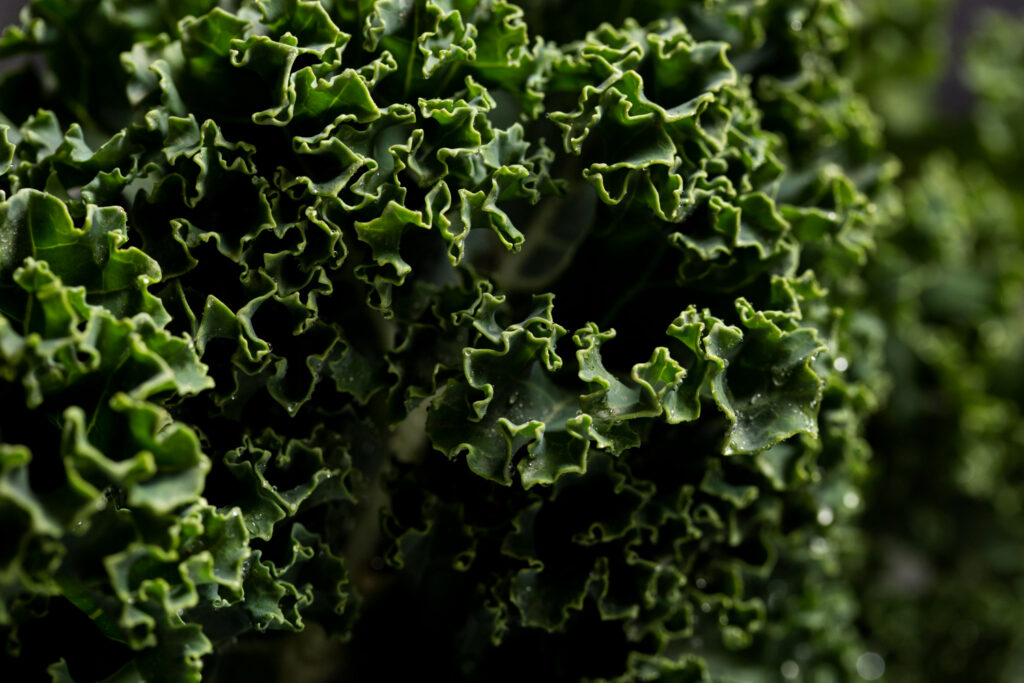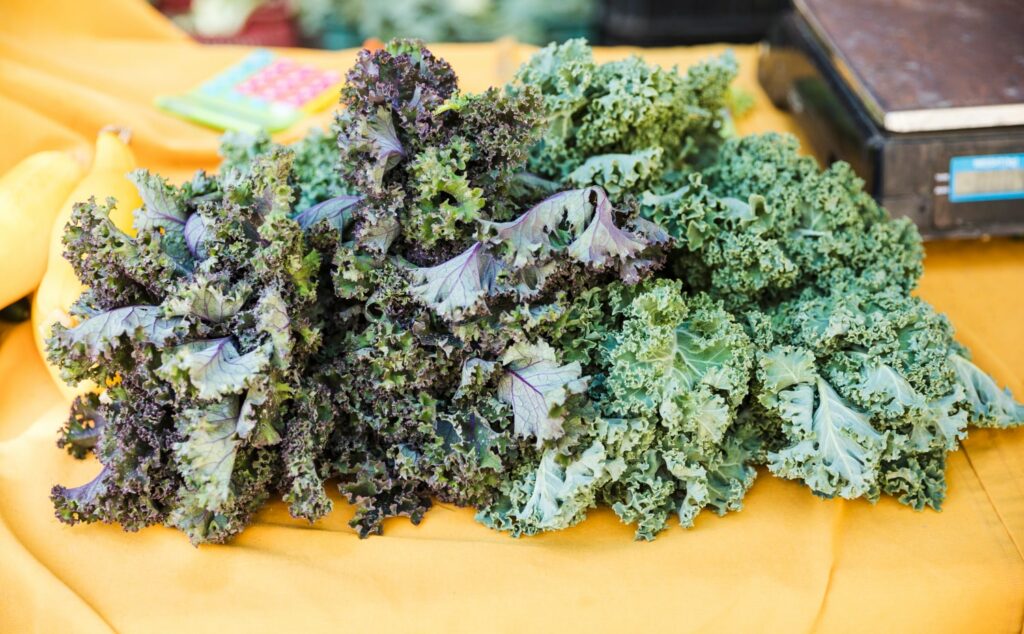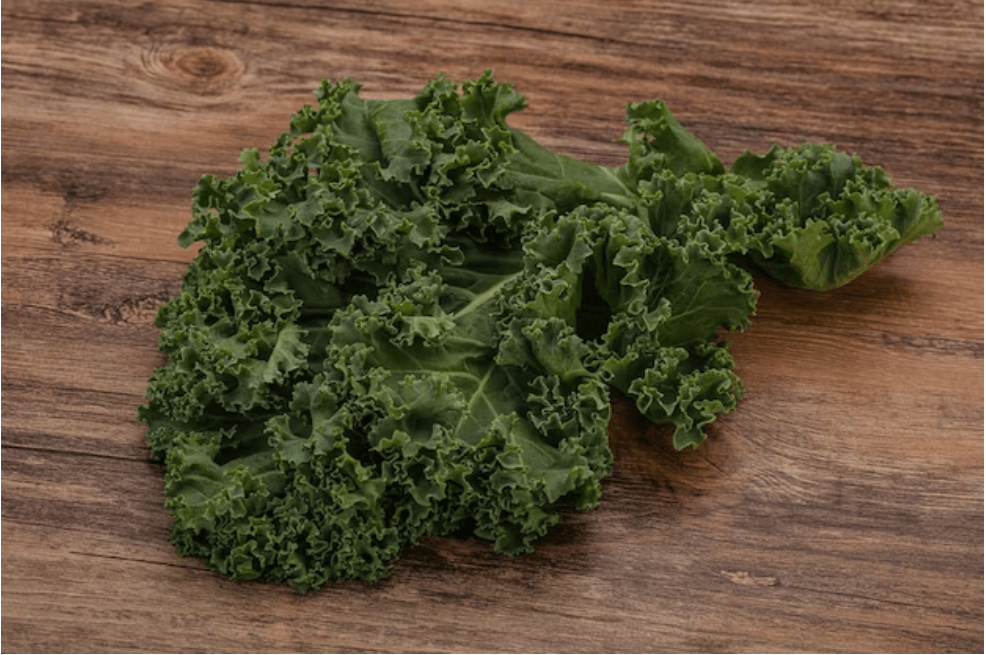Can dogs eat kale? It’s a common question that many dog owners ask when considering adding new foods to their furry friend’s diet. Kale has gained popularity as a superfood among humans, packed with vitamins, minerals, and antioxidants. While it may seem like a healthy choice for dogs as well, it’s important to consider the potential benefits and risks of feeding kale to your dog. In this article, we will explore whether can dogs eat kale and the potential benefits and drawbacks to keep in mind.
Can dogs have kale?

Yes, dogs can have kale in moderation. Kale is a nutrient-dense vegetable that offers many health benefits for both humans and dogs. It is a good source of vitamins A, C, and K, as well as calcium, iron, and antioxidants. However, it’s important to note that too much kale can cause digestive upset and can interfere with the absorption of certain minerals.
Additionally, dogs with certain medical conditions, such as kidney disease, may need to avoid kale altogether. As with any new food, it’s best to introduce kale gradually and in small amounts to monitor your dog’s reaction. Always consult with your veterinarian before making any significant changes to your dog’s diet.
Can puppies eat kale?
Puppies can eat kale in moderation as part of a balanced diet. But you should give your puppy kale slowly and in small amounts so you can watch how it reacts. Puppies have delicate digestive systems that are still developing, so it’s essential to introduce new foods slowly to avoid digestive upset. Additionally, puppies have different nutritional requirements than adult dogs and may require a different balance of nutrients in their diet.
While kale is a nutritious vegetable, it’s important to keep in mind the potential risks associated with feeding kale to puppies. Puppies may be more susceptible to the harmful effects of goitrogens and oxalates found in kale. Therefore, it’s important to consult with a veterinarian before feeding kale to your puppy, especially if they have an existing health condition.
What types of kale can dogs eat? Can dogs eat curly kale?
Dogs can eat different types of kale, including curly kale, Lacinato kale (also known as Tuscan or dinosaur kale), and Russian kale. These types of kale are all safe for dogs to eat, as long as they are prepared appropriately.
- Curly kale, which is a type of kale with tightly curled leaves, is a nutritious vegetable that can provide several health benefits to dogs. It’s a good source of vitamins, as well as minerals like calcium and iron. When feeding curly kale to your dog, it’s important to wash the leaves thoroughly and remove any tough stems or ribs that may be difficult for your dog to digest.
- Lacinato kale and Russian kale are other types of kale that are safe for dogs to eat. These varieties of kale have slightly different textures and flavors than curly kale, but they offer similar nutritional benefits.
Regardless of the type of kale you choose to feed your dog, it’s important to introduce it gradually and in small amounts to monitor your dog’s reaction. While kale is a nutritious vegetable that can provide several health benefits to dogs, it’s important to feed it in moderation and as part of a balanced diet.
Is kale good for dogs? What are the benefits

Yes, kale can be good for dogs as it is a highly nutritious vegetable that can provide a range of health benefits. Here are some of the nutritional benefits of kale for dogs:
Rich in vitamins and minerals
Kale is an excellent source of vitamins A, C, and K, as well as calcium, iron, and potassium. These nutrients are essential for maintaining healthy bones, teeth, and muscles, and supporting the immune system.
High in antioxidants
Kale contains high levels of antioxidants, such as beta-carotene and lutein, which can help protect cells from damage caused by free radicals.
Low in calories
Kale is a low-calorie vegetable, making it a great option for dogs who need to maintain a healthy weight or lose weight.
High in fiber
Kale is high in fiber, which can help regulate digestion and promote bowel regularity.
Anti-inflammatory properties
Kale contains anti-inflammatory compounds that can help reduce inflammation in the body, which can be beneficial for dogs with conditions such as arthritis.
Overall, kale can be a healthy addition to a dog’s diet in moderation. However, it’s important to introduce it gradually and monitor your dog’s reaction, as some dogs may have difficulty digesting it.
Is kale bad for dogs?
While kale can be a healthy addition to a dog’s diet, consuming too much kale can be harmful and potentially toxic to dogs and it’s also a reason why can dogs not eat kale too much. Here are some potential risks of feeding kale to your dog:
- Interference with thyroid function: Kale contains goitrogens, which are compounds that can interfere with thyroid function in dogs. Dogs who have an existing thyroid condition should avoid consuming large amounts of kale.
- Oxalates: Kale, like many leafy greens, contains oxalates, which can cause kidney and bladder problems in dogs when consumed in large quantities.
- Digestive upset: Kale is high in fiber, which can cause digestive upset such as gas, bloating, and diarrhea in some dogs, especially if they are not used to consuming high-fiber foods.
- Pesticides: Kale is one of the vegetables that is often heavily sprayed with pesticides, which can be harmful to dogs if consumed in large amounts.
In conclusion, while kale can be a nutritious addition to a dog’s diet when fed in moderation, it’s important to be aware of the potential risks and to consult with your veterinarian before making any significant changes to your dog’s diet.
Which parts of kale can you feed your dog?

When it comes to feeding kale to your furry friend, it’s important to know which parts are safe and nutritious for your dog. While kale is a nutrient-dense vegetable that can provide several health benefits, not all parts of the vegetable are suitable for canine consumption. In this article, we will discuss which parts of kale you can feed your dog
Can dogs eat kale leaves?
Yes, dogs can eat kale leaves. Kale leaves are the most commonly consumed part of the vegetable and can be a healthy addition to your dog’s diet. Kale is a nutrient-dense vegetable that is low in calories and high in vitamins and minerals, making it an excellent choice for dogs.
Before feeding kale leaves to your dog, it’s important to wash them thoroughly and remove any tough stems or ribs that may be difficult for your dog to digest. Kale leaves can be served raw, steamed, or sautéed, depending on your dog’s preferences and dietary needs. Additionally, it’s important to introduce kale leaves gradually and in small amounts to monitor your dog’s reaction.
While kale leaves are generally safe for dogs to eat, it’s important to keep in mind that each dog is different and may have difficulty digesting certain foods. It’s always a good idea to consult with your veterinarian before adding new foods to your dog’s diet.
Can dogs eat kale stems?
Dogs can eat kale stems in moderation. However, kale stems are more fibrous and tough than the leaves, and some dogs may have difficulty digesting them. It’s important to chop the kale stems into small pieces or cook them to make them easier for your dog to chew and digest.
Kale stems are also a good source of fiber and nutrients, such as calcium and iron, making them a nutritious addition to your dog’s diet. However, it’s important to introduce kale stems gradually and in small amounts to monitor your dog’s reaction.
It’s worth noting that kale stems, like other cruciferous vegetables, contain compounds called glucosinolates that can interfere with thyroid function in dogs if consumed in large amounts. Therefore, dogs with thyroid issues should avoid consuming large amounts of kale stems.
Can dogs eat kale stalks?
Kale stalks are the tough, woody part of the vegetable, and dogs should not eat them. Kale stalks are too fibrous and difficult for dogs to digest properly, and they can potentially cause digestive issues or even pose a choking hazard.
While kale is a nutritious vegetable that can provide several health benefits to dogs, it’s important to feed them the right parts of the vegetable. Kale leaves and stems are generally safe for dogs to eat in moderation, but it’s important to prepare them appropriately and remove any tough or woody parts.
Can dogs eat kale chips?
Dogs can eat kale chips in moderation, but it’s important to choose plain, unsalted kale chips. Flavored or seasoned kale chips may contain harmful ingredients such as onion or garlic powder, which can be toxic to dogs.
Kale chips are a popular human snack that is made by baking or dehydrating kale leaves until they become crispy. While kale chips can be a healthy and low-calorie treat for dogs, it’s important to keep in mind that they are also high in fiber and can cause digestive upset, especially if fed in large quantities.
If you’re feeding kale chips to your dog, it’s important to do so in moderation and to monitor their reaction. It’s also a good idea to introduce new foods to your dog’s diet gradually and in small amounts to prevent any digestive issues.
How to prepare kale for dogs?
Well how do you give kale to your dog safely?
Due to the differences between dogs and people, cooking kale for your dog will differ from making it for yourself. We show you how to cook kale for your dog and provide instructions.
First and foremost, always keep in mind that kale can be cooked as long as no additional ingredients are added.
- Purchase organic kale to lower your chance of consuming chemicals and heavy metals.
- If you can’t find organic kale, try adding some cilantro or chlorella to help your dog’s body eliminate the thallium.
- To get rid of as much of the pesticide from the leaves as possible, properly wash the kale before giving it to the puppies.
- To lessen kale’s impact on thyroid hormone production, lightly steam it.
- You can also purée kale because your dog’s digestive system is different, and it will be simpler for them to eat and digest if you cut or purée this leafy green.
- Consistently include kale or other green leafy vegetables in your diet along with a protein source like chicken or beef.
Can dogs eat kale raw?
Dogs can eat raw kale, but it’s important to prepare it appropriately and serve it in moderation. Raw kale can be difficult for some dogs to digest, and the fibrous nature of kale can cause digestive upset or even blockages if consumed in large quantities.
When feeding raw kale to your dog, it’s important to chop it finely or puree it to make it easier for your dog to chew and digest. You should also make sure to wash the kale thoroughly and remove any tough stems or ribs that may be difficult for your dog to digest.
It’s worth noting that some dogs may have difficulty digesting raw kale or may be more susceptible to the risks associated with consuming kale. Therefore, it’s always a good idea to introduce new foods to your dog’s diet gradually and in small amounts to monitor their reaction.
Can dogs eat cooked kale?
Yes, dogs can eat cooked kale, and it can be a healthy addition to their diet. Cooking kale can make it easier for dogs to digest and can also help to release more nutrients from the vegetable.
When cooking kale for your dog, it’s important to avoid adding any seasonings or ingredients that may be harmful to your dog, such as garlic or onion powder. Plain cooked kale is the best option for your dog.
Even though cooked kale is usually safe for dogs to eat, it’s best to give it to them slowly and in small amounts so you can see how they react. Like any new food, cooked kale may be hard for some dogs to digest, or they may be more likely to get sick if they eat it.
How much kale can dogs eat?

The amount of kale that dogs can eat depends on their size, age, and overall health. While kale is a nutritious vegetable that can provide several health benefits to dogs, it should be fed in moderation and as part of a balanced diet.
As a general rule, vegetables should make up no more than 10% of a dog’s diet. Therefore, the amount of kale that you feed your dog should be limited to a small portion of their overall diet.
A good starting point is to feed your dog 1-2 tablespoons of cooked or raw kale per day for every 10 pounds of body weight. However, it’s important to monitor your dog’s reaction to kale and adjust the amount accordingly. Some dogs may have difficulty digesting kale or may be more susceptible to the risks associated with consuming kale, so it’s always a good idea to introduce new foods to your dog’s diet gradually and in small amounts.
How often can a dog eat kale?
While kale is a healthy and nutritious vegetable for dogs, it’s important to feed it in moderation and as part of a balanced diet. As a general guideline, you can offer kale to your dog once or twice a week, depending on their overall diet and individual nutritional needs.
It’s necessary to remember that dogs have different nutritional requirements than humans, and their digestive systems may not be able to handle large amounts of vegetables. Too much kale can lead to digestive upset, and may cause gas or diarrhea in some dogs.
What can be incorporated with kale?
Kale is a nutrient-dense vegetable that can provide several health benefits to dogs when fed in moderation and as part of a balanced diet. While kale can be served alone as a healthy snack or meal addition, there are many other vegetables that can be incorporated with kale to provide a nutritious and delicious meal for your dog
Can dogs eat kale and spinach?
Yes, dogs can eat both kale and spinach, which are both nutritious vegetables that can provide several health benefits. Kale and spinach are both rich in vitamins and minerals, including vitamins A, C, and K, as well as iron, calcium, and antioxidants.
When feeding kale and spinach to your dog, it’s important to prepare them appropriately and serve them in moderation. Both vegetables should be washed thoroughly, and any tough stems or ribs should be removed before feeding them to your dog. Additionally, it’s important to chop the vegetables into small pieces or puree them to make them easier for your dog to chew and digest.
Can dogs eat chard and kale?
Yes, dogs can eat chard and kale, which are both healthy vegetables that can provide several nutritional benefits. However, there are some differences in the nutritional content and potential risks associated with feeding these vegetables to dogs.
Chard is a leafy green vegetable that is high in vitamins A, C, and K, as well as minerals like magnesium and potassium. Chard is also a good source of antioxidants and fiber, making it a healthy addition to your dog’s diet. However, like kale and other leafy greens, chard contains oxalates, which can contribute to the formation of calcium oxalate stones in some dogs.
Kale is a cruciferous vegetable that is high in vitamins A, C, and K, as well as minerals like calcium and iron. Kale is also a good source of antioxidants and fiber, making it a healthy addition to your dog’s diet. However, kale also contains compounds called glucosinolates, which can interfere with thyroid function in dogs if consumed in large amounts.
Overall, chard and kale can be healthy additions to your dog’s diet when fed in moderation and as part of a balanced diet. However, it’s important to be aware of the potential risks associated with these vegetables and to consult with your veterinarian before adding any new foods to your dog’s diet.
Can dogs eat kale and broccoli?
Yes, dogs can eat kale and broccoli. Both of these vegetables are healthy and good for them in many ways. Both kale and broccoli are full of vitamins and minerals, antioxidants, and fiber.
What can you do if your dog eats excess kale?
If your dog has eaten excess kale, there are some steps you can take to help prevent any potential health issues or complications. Here’s what you can do if your dog eats excess kale:
- Monitor your dog: Keep an eye on your dog for any signs of digestive upset, such as vomiting, diarrhea, or lethargy. If you notice any of these symptoms, it’s important to contact your veterinarian.
- Provide fresh water: Encourage your dog to drink plenty of fresh water, which can help to flush out their system and prevent dehydration.
- Adjust their diet: If your dog has consumed a large amount of kale, you may need to adjust their diet to help prevent any digestive issues. Consider feeding them a bland diet of boiled chicken and rice for a day or two until their system has had a chance to recover.
- Consult with your veterinarian: If you’re concerned about your dog’s health or if they have any pre-existing health conditions, it’s important to consult with your veterinarian for guidance on the best course of action.
In general, it’s always a good idea to feed kale and other vegetables to your dog in moderation and as part of a balanced diet. If your dog has eaten excess kale or any other food, it’s important to monitor their health and take appropriate action to prevent any potential complications.
FAQs
Can kale be used as a substitute for commercial dog food?
No, kale cannot be used as a substitute for commercial dog food. Dogs require a balanced and complete diet that includes protein, fat, carbohydrates, vitamins, and minerals.
Can kale help with a dog’s weight management?
Yes, kale can help with a dog’s weight management. Kale is low in calories but high in fiber, which can help your dog feel full and satisfied without consuming too many calories.
Can I give my dog kale smoothies or juice?
No, it is not recommended to give your dog kale smoothies or juice. Dogs require whole foods and consuming kale in a smoothie or juice form can lead to digestive issues and may not provide the same nutritional benefits as whole kale.
Can kale cause digestive issues in dogs?
Yes, kale can cause digestive issues in dogs if consumed in large quantities. It is recommended to introduce kale gradually into your dog’s diet and monitor for any signs of gastrointestinal upset.
Can kale be used as a treat for dogs?
Yes, kale can be used as a treat for dogs. Kale chips or baked kale can be a healthy and low-calorie treat option for dogs. However, it is important to avoid adding any seasonings or spices to the kale as they can be harmful to dogs.
Conclusion
To sum up, the answer to the question can dogs eat kale? is a qualified yes. While kale can provide several health benefits to dogs, including vitamins, fiber, and antioxidants, it should be given in moderation and with certain precautions. Ultimately, incorporating kale into your dog’s diet can be a healthy and tasty addition, but it should always be done with care and attention to your pet’s specific needs. If you have any concerns or questions about your dog’s diet, we encourage you to speak with your veterinarian.

